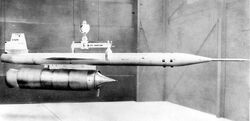
X-7
Footage of the first flight of the Lockheed X-7 Test vehicle. This drone was powered by a Wright Aeronautical Ramjet developed for the North American Aviation Navaho Cruise Missile.

Lockheed X-7-0
The Lockheed X-7 (dubbed the "Flying Stove Pipe") was an American unmanned test bed of the 1950s for ramjet engines and missile guidance technology. It was the basis for the later Lockheed AQM-60 Kingfisher, a system used to test American air defenses against nuclear missile attack. The aircraft is one of the lesser known designs by Kelly Johnson, who went on to become the creator of the SR-71 family of aircraft.
Background[]
With overestimated reports of a huge Soviet bomber fleets and new ICBMs popping up in a the Soviet countryside America became frightened. The USA thus wanted a system used to test American air defenses against nuclear missile attack and further anti-aircraft weapons development. The Korean War was also occering at this time.
The idea[]
The Lockheed X-7 (dubbed the "Flying Stove Pipe") was a cutting edge American unmanned test bed of the 1950s for ramjet engines and missile guidance technology. It was the basis for the later Lockheed AQM-60 Kingfisher, a system used to test American air defenses against nuclear missile attack.
It was to be an unmanned test bed of the latest 1950s ramjet engines and missile guidance technology.
The aircraft is one of the lesser known designs by Kelly Johnson, who went on to become the creator of the SR-71 family of aircraft
Deisinge and development[]

A X-7 being dropped.
A booster ignited after launch and propelled the vehicle to a speed of 1,000mph (1,625km/h). The booster was then jettisoned, and the underslung ramjet took over from that point. The X-7 eventually returned to Earth, its descent slowed by parachute.
The X-7 was unique in that it was constructed of steel, as opposed to the titanium used on later ramjets such as the more well known SR-71, and its predecessors, the Lockheed A-12 and YF-10. The X-2 test aircraft preceded the X-7 by having Stainless steel wings, but its fuselage was composed of Nickel alloy. Steel was not widely used in aircraft until the later Mig-25 Foxbat.
The X-7 was also used to test HEF-2 and Hi Cal-3 zip fuel, which has a superior heating value of 26,500 British thermal unit(Btu)/lb. compared to hydrocarbon fuel with 18,400 Btu/lb.
The missile it's self[]

The Lockheed X-7 missile.
The X-7 was unique in that it was constructed of steel, as opposed to the titanium used on later ramjets such as the more well known SR-71, and its predecessors, the A-12 and YF-10. The X-2 test aircraft preceded the X-7 by having Stainless steel wings, but its fuselage was composed of Nickel alloy. Stanless steel was not widely used in aircraft until the much later launch of the Soviet Mig-25 Foxbat.
Stats[]
- Role: Experimental aircraft.
- Manufacturer: Lockheed Corporation.
- First flight: April 26, 1951.
- Retired: 1960.
- Primary user: United States Air Force (USAF).
- Developed into: The AQM-60 Kingfisher.
- Launched from: A B-29 or B-50 Superfortress.
- Specifications given for: (X-7A-1).
- Crew: None.
- Length: 32 ft 9 in (9.98 m).
- Wingspan: 12 ft (3.66 m).
- Height: 7 ft (2.1 m).
- Loaded weight: 8,000 lb (3,600 kg).
- Powerplant: 1 × Alleghany Ballistics Laboratories X202-C3 solid-fuel rocket, 105,000 lbf (467 kN) 1 × various Marquardt MA20 ramjets under test, (?).
- Maximum speed: Mach 4.31 (2,881 mph, 4,640 km/h).
- Flight height's service ceiling: 106,000 ft (32,317 m).
- Weight: N\A, but probably akin to those of comparable role, configuration and era.
World record[]
A maximum speed of 2,881 mph (4640 km/h / Mach 4.31) was attained, setting a record for fastest air-breathing aircraft at the time. A total of 130 X-7 flights were conducted from April 1951 to July 1960.
Also see[]
- Space rockets
- Missiles
- American X-aircraft
- Lockheed X-17
- Moor 1969 Jet Pack
- Bell Pogo
- Science
- Bell X-1
- Lockheed X-17
- 1960 Bomarc Missile accident
- CIM-10 Bomarc missile
Online links[]
- https://en.wikipedia.org/wiki/Lockheed_X-7
- http://www.456fis.org/LOCKHEED_X-7.htm
- https://duckduckgo.com/Lockheed_X-7?ia=about
- http://www.aero-web.org/specs/lockheed/x-7.htm
- https://en.wikipedia.org/wiki/Lockheed_X-7
- http://www.globalsecurity.org/military/world/russia/mig-25.htm
- http://www.foia.cia.gov/docs/DOC_0001465813/DOC_0001465813.pdf